Mount Sinai Hospital (Manhattan)
| Mount Sinai Hospital | |
|---|---|
| Mount Sinai Health System | |
 | |
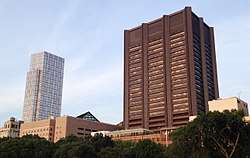 Buildings of Mount Sinai seen from Central Park | |
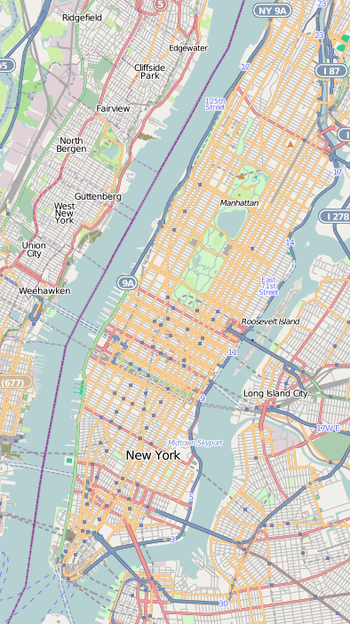  | |
| Geography | |
| Location |
1 Gustave L. Levy Place and 1468 Madison Avenue, East Harlem, New York City, New York, United States |
| Coordinates | 40°47′24″N 73°57′12″W / 40.790066°N 73.953249°WCoordinates: 40°47′24″N 73°57′12″W / 40.790066°N 73.953249°W |
| Organization | |
| Funding | Non-profit hospital |
| Hospital type | University, Teaching |
| Affiliated university | Icahn School of Medicine at Mount Sinai |
| Network | Mount Sinai Health System |
| Services | |
| Beds | 1,141[1] |
| History | |
| Founded | 1852[2] |
| Links | |
| Website |
www |
| Lists | Hospitals in New York |
| Other links | Hospitals in New York City |
Mount Sinai Hospital, founded in 1852, is one of the oldest and largest teaching hospitals in the United States.[2] It is located on the eastern border of Central Park stretching along Fifth Avenue between 98th and 103rd Street in the New York City borough of Manhattan.
Affiliates
Mount Sinai also has a number of hospital affiliates in the New York metropolitan area including Brooklyn Hospital Center, and an additional campus, Mount Sinai Hospital of Queens. The hospital is also affiliated with the Icahn School of Medicine at Mount Sinai, which opened in September 1968.[3] In 2013, Mount Sinai Hospital joined with Continuum Health Partners in the creation of the Mount Sinai Health System. The system encompasses the Icahn School of Medicine at Mount Sinai and seven hospital campuses in the New York metropolitan area, as well as a large, regional ambulatory footprint.[4]
Rankings
In 2017–18, Mount Sinai Hospital was recognized on the U.S. News & World Report "Best Hospitals Honor Roll," ranking 18th among the approximately 5,000 hospitals in the US with 10 nationally ranked specialties including cardiology & heart surgery (#9), diabetes & endocrinology (#19), gastroenterology & GI surgery (#8), geriatrics (#3), gynecology (#23), nephrology (#10), and neurology & neurosurgery (#16).[5] Additionally, Mount Sinai Hospital was ranked 2nd regionally in both the New York City and New York metro area.[6]
Previously, Mount Sinai Hospital was ranked 16th on the U.S. News & World Report 2014-15 "Best Hospitals Honor Roll"[7] and 15th on the U.S. News & World Report 2016-17 "Best Hospitals Honor Roll."[8]
History
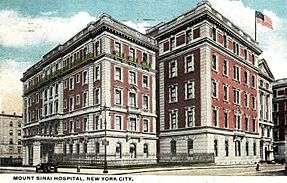
As U.S. cities grew more crowded in the mid-19th century, philanthropist Sampson Simson (1780–1857) founded a hospital to address the needs of New York's rapidly growing Jewish immigrant community. It was the second Jewish hospital in the United States. At the time of its founding in 1852, other hospitals in New York City discriminated against Jews by not hiring them and preventing them from being treated in their wards.[9]
The Jews' Hospital in the City of New York, as it was then called, was built on 28th Street in Manhattan, between 7th and 8th Avenues, on land donated by Simson; it opened two years before Simson's death. Four years later, it was unexpectedly filled to capacity with soldiers from the Civil War.[10][11]
The Jews' Hospital felt the effects of the escalating Civil War in other ways, as staff doctors and board members were called into service: Dr. Israel Moses served four years as lieutenant colonel in the 72nd;[12] Joseph Seligman had to resign as a member of the board of directors, as he was increasingly called upon by President Lincoln for advice on the country's growing financial crisis.[13][14]
The Draft Riots of 1863 again strained the resources of the new hospital, as draft inequities and a shortage of qualified men increased racial tensions in New York City. As the Jews' Hospital struggled to tend to the many wounded, outside its walls over 100 men, and children were killed in the riots.[15]
More and more, the Jews' Hospital was finding itself an integral part of the general community. In 1866, to reflect this new-found role, it changed its name. In 1872, the hospital moved uptown to the east side of Lexington Avenue, between 66th and 67th Streets.[16][17]
Now called Mount Sinai Hospital, the institution forged relationships with many physicians who made contributions to medicine, including Henry N. Heineman, Frederick S. Mandelbaum, Bernard Sachs, Charles A. Elsberg, Emanuel Libman, and, most significantly, Abraham Jacobi, known as the father of American pediatrics and a champion of construction at the hospital's new site on Manhattan's Upper East Side in 1904.[18]
The hospital established a school of nursing in 1881. Created by Alma deLeon Hendricks and a small group of women, Mount Sinai Hospital Training School for Nurses was taken over by the hospital in 1895. In 1923, the name was changed to Mount Sinai Hospital School of Nursing. This school closed in 1971 after graduating 4,700 nurses—all women except one man in the last class. An active alumnae association continues.
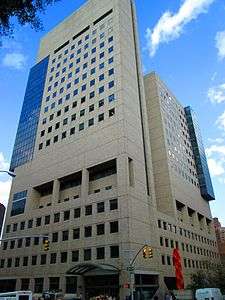
The early 20th century had the population of New York City explode. That, coupled with many new discoveries at Mount Sinai (including significant advances in blood transfusions and the first endotracheal anesthesia apparatus), meant that Mount Sinai's pool of doctors and experts was in increasing demand. A $1.35 million expansion of the 1904 hospital site (equivalent to over $30 million in 2008)[19] raced to keep pace with demand. The opening of the new buildings was delayed by the advent of World War I. Mount Sinai responded to a request from the United States Army Medical Corps with the creation of Base Hospital No.3. This unit went to France in early 1918 and treated 9,127 patients with 172 deaths: 54 surgical and 118 medical, the latter due mainly to influenza and pneumonia.
Two decades later, with tensions in Europe escalating, a committee dedicated to finding placements for doctors fleeing Nazi Germany was founded in 1933. With the help of the National Committee for the Resettlement of Foreign Physicians, Mount Sinai Hospital became a new home for a large number of émigrés. When World War II broke out, Mount Sinai was the first hospital to throw open its doors to Red Cross nurses' aides; the hospital trained many in its effort to reduce the nursing shortage in the States. Meanwhile, the president of the medical board, George Baehr, M.D., was called by President Roosevelt to serve as the nation's Chief Medical Director of the Office of Civilian Defense.[20]
These wartime roles were eclipsed, however, when the men and women of Mount Sinai's 3rd General Hospital set sail for Casablanca, eventually setting up a 1,000-bed hospital in war-torn Tunisia. Before moving to tend to the needs of soldiers in Italy and France, the 3rd General Hospital had treated more than 5,000 wounded soldiers.[21]
In the decades following World War II, Mount Sinai has continued its efforts to expand its usefulness to medicine and its communities. In 1963, the hospital created a medical school, and in 1968 welcomed the first students of Mount Sinai School of Medicine, now the Icahn School of Medicine at Mount Sinai. The 1980s had a $500 million hospital expansion, including the construction of the Guggenheim Pavilion, the first medical facility designed by I.M. Pei; the faculty has made significant contributions to gene therapy, cardiology, immunotherapy, organ transplants, cancer treatments, and minimally invasive surgery.
Writing for The Boston Globe on 14 October 2007, Scott Allen reported the issue of patient abuse and problems with human resources management at Mount Sinai by Dr. Jack M. Gorman who was Department Chairman of Psychiatry at Mount Sinai. Allen stated that; "... officials at McLean learned that Gorman had, like so many patients at the renowned psychiatric hospital, attempted suicide. But their initial sympathy for a sick man turned to horror when they learned, from a legal document delivered in mid-May, why he had taken such a desperate measure. The married father of two had brought a shameful secret with him to Massachusetts: He had engaged in a long-term sexual relationship with a New York patient... Gorman, 55, inspired great hope when McLean and Partners announced that they had lured him away from New York City's Mount Sinai School of Medicine in October 2005... It was Gorman's decision to contact the New York Board of Professional Medical Conduct that finally brought the episode to public attention. Earlier this month, the board finally acted on what Gorman told them, posting on its website that his medical license had been indefinitely suspended for 'inappropriate sexual contact' with a patient."[22]
The issue of human resources management between nurses and doctors at Mount Sinai hospital was reported by Jose Martinez on April 20, 2010 in the New York Daily News. As stated by Martinez: "A Catholic nurse was forced to assist in an abortion at Mount Sinai Medical Center over her strenuous objections, a lawsuit filed Friday charges. Catherina Cenzon-DeCarlo, who works in the operating room at the Manhattan hospital, contends that her boss ordered her to assist in the May 2009 abortion of a 22-week-old fetus or face charges of 'insubordination and patient abandonment.'"[23]
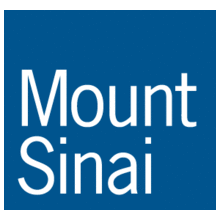
In January 2013 David L. Reich was the first openly gay medical doctor named Interim President of Mount Sinai Hospital as reported by The New York Times;[24] in October of the same year he was named president.[25][26] On November 24, 2002, The New York Times reported the commitment ceremony of Reich to Keith Loren Marran stating that: "Keith Loren Marran Jr. and Dr. David Louis Reich are to celebrate their partnership today with a commitment ceremony at the Bloom Ballroom in Manhattan. Judge Paul G. Feinman of New York City Civil Court in Manhattan will officiate." [24]
James McKinley writing for The New York Times reported abuse issue investigations dealing with human resources management at Mount Sinai Hospital on March 24, 2016 when a doctor was brought to court for abuse of several patients. As stated by McKinley: "A former doctor at Mount Sinai Hospital in Manhattan was arraigned on Thursday on charges of sexually abusing four women who came into the emergency room there, touching their breasts for no medical reason and, in one case, drugging, groping and masturbating on a patient. The physician, Dr. David H. Newman, pleaded not guilty before Justice Michael J. Obus in State Supreme Court in Manhattan to one count of first-degree sexual abuse and four counts of third-degree sexual abuse. He remains free on bail. 'Four young women who came to the hospital for medical treatment were sexually abused by the very doctor entrusted with their care,' the Manhattan district attorney, Cyrus R. Vance Jr., said in a statement."[27]
In August 2016 Dennis S. Charney, the Dean of the medical school, was shot and wounded as he left a deli in his home town of Chappaqua, New York. Hengjun Chao, a former Mount Sinai faculty member who had been fired for research misconduct in 2010, was arrested and charged with attempted murder.[28][29] Chao was convicted of attempted second degree murder and two other charges in June 2017.[30]
On March 16, 2018 Brendan Pierson writing for Reuters and Katie Thomas writing for The New York Times reported that several doctors from Mount Sinai Hospital were charged in Federal Court for participating in a Fentanyl prescription kickback and bribery case stating: "The five doctors were arrested on Friday morning and face charges including that they violated the federal anti-kickback law and conspired to commit fraud. They pleaded not guilty on Friday before U.S. Magistrate Judge Sarah Netburn in Manhattan and were released on bail."[31][32] The doctors were identified as Gordon Freedman of the Department of Anestesiology, Dialecti Voudouris of the Department of Oncology, and Alexandru Burducea of the Department of Anesthesiology.[33][34]
Noteworthy individuals
Noted benefactors
- Leon Black donated $10 million to create the Black Family Stem Cell Institute.[35]
- Carl Icahn donated $25 million to Mount Sinai Medical Center for advanced medical research; a large building primarily devoted to research was renamed from the "East Building" to the "Icahn Medical Institute."[36] In 2012, Icahn pledged $200 million to the institution.[37] In exchange, the medical school was renamed the Icahn School of Medicine at Mount Sinai and the genomics institute led by Eric Schadt was renamed the Icahn Institute for Genomics and Multiscale Biology.
- Frederick Klingenstein, former CEO of Wertheim & Co., and wife Sharon Klingenstein donated $75 million, the largest single gift in the history of Mount Sinai, to establish an institute for scientific research and create a scholarship fund.[38]
- Henry Kravis and wife Marie-Josée Kravis donated $15 million to establish the "Center for Cardiovascular Health" as well as funding a professorship.
- Samuel A. Lewis, NYC political leader and philanthropist who served for 21 years (1852–1873) as the first Director, then Honorary Secretary, and finally Chairman of the Executive Committee.
- Hermann Merkin gave $2 million in dedication of the kosher kitchen at the hospital.
- Derald Ruttenberg donated $7 million to establish the Ruttenberg Cancer Center at Mount Sinai and later contributed $8 million more.[39]
- Martha Stewart donated $5 million to start the Martha Stewart Center for Living at Mount Sinai Hospital. The center promotes access to medical care and offers support to caregivers needing referrals or education.[40]
- James Tisch and wife Merryl Tisch donated $40 million to establish The Tisch Cancer Institute, a state-of-the-art, patient-oriented comprehensive cancer care and research facility.[41]
Noted staff
- Sander S. Florman, Director of Recanati/Miller Transplant Institute.[42]
- Jacob M. Appel (born 1973), bioethicist and liberal commentator[43]
- Burrill Bernard Crohn (1884–1983), gastroenterologist and one of the first to describe the disease of which he is the namesake, Crohn's disease.[44]
- Valentin Fuster (born 1943), Director of Mount Sinai Heart, The Zena and Michael A. Wiener Cardiovascular Institute, The Marie-Josée and Henry R. Kravis Center for Cardiovascular Health, The Richard Gorlin, MD/Heart Research Foundation Professor, Icahn School of Medicine at Mount Sinai
- Irving B. Goldman (1898–1975), first president of the American Academy of Facial Plastic and Reconstructive Surgery, 1964
- Jonathan L. Halperin, Director of Clinical Cardiology in the Zena and Michael A. Wierner Cardiovascular Institute
- Michael Heidelberger (1888–1981), immunologist who is regarded as the father of modern immunology
- Abraham Jacobi (1830–1919), pediatrician and president of the American Medical Association. Pioneer of pediatrics In the US, devoted to women's and children's welfare.
- Blair Lewis, gastroenterologist who helped develop the American Gastroenterological Association's position statement on occult and obscure gastrointestinal bleeding
- Isidor Clinton Rubin (1883–1958), gynecologist and infertility specialist
- Jonas Salk, inventor of the polio vaccine, worked as a staff physician at Mount Sinai after medical school[45]
- Milton Sapirstein, clinical psychiatrist. Sought "to mesh the advances being made in neurobiology in the 1940's with psychoanalytic concepts."[46]
- Helen S. Mayberg, founding director of the Center for Advanced Circuit Therapeutics
See also
References
Notes
- ↑ Mount Sinai: Facts and Figures. Accessed 19 March 2018
- 1 2 "About The Mount Sinai Hospital". Icahn School of Medicine at Mount Sinai. Retrieved April 14, 2017.
- ↑ Mount Sinai School of Medicine: History retrieved on April 28, 2010.
- ↑ Mount Sinai: About Us
- ↑ U.S. News & World Report: Mount Sinai Hospital
- ↑ U.S. News & World Report: Mount Sinai Hospital
- ↑ U.S. News & World Report: 2014-15 Best Hospitals Rankings
- ↑ U.S. News & World Report: 2016-17 Best Hospitals Rankings
- ↑ "When the Jews congregated at Mount Sinai," Jerusalem Post.
- ↑ This House of Noble Deeds, Mount Sinai Hospital, 1852 – 2002, Arthur H. Aufses, Jr. and Barbara J. Niss, New York University Press
- ↑ Mount Sinai: Mount Sinai Hospital: History
- ↑ The Chattanooga Civil War Round Table
- ↑ The Civil War Dictionary Archived 2008-04-29 at the Wayback Machine.
- ↑ From Pack Peddler to International Banker: The Life and Times of Joseph Seligman
- ↑ Answers.com – New York Draft Riots
- ↑ "New Buildings – Description of the Mount Sinai Hospital, and the St. John's M. E. Church in Fifty-third-street". The New York Times. May 15, 1870. p. 6. Retrieved May 25, 2016.
Our Jewish fellow-citizens are about to erect, on the cast side of Lexington-avenue, between Sixty-sixth and Sixty-seventh streets, a spacious edifice for the accommodation of persons of their own faith, and to be known as the Mount Sinai Hospital
- ↑ "Mount Sinai Hospital – Inauguration of the New Buildings – Gov. Hoffman's Address – Description of the Edifice". The New York Times. May 30, 1872. p. 2. Retrieved May 25, 2016.
- ↑ FAQs.org – Abraham Jacobi Biography
- ↑ Measuringworth.com
- ↑ American Journal of Public Health, June 1943
- ↑ Veterans' History Project: Interview with Isabelle Cook
- ↑ The Boston Globe. October 14, 2007
- ↑ New York Daily News, April 30, 2010
- 1 2 The New York Times, November 24, 2002.
- ↑ Bloomberg News Bloomberg profile of David L. Reich Page accessed May 3, 2015
- ↑ "David L. Reich, MD, Named President of The Mount Sinai Hospital". Retrieved May 20, 2014.
- ↑ The New York Times. James McKinley, March 24, 2016
- ↑ Bromwich, Jonah Engel (29 August 2016). "Fired Professor Shot 2 Men Outside Chappaqua Deli, Police Say". The New York Times.
- ↑ Guarino, Ben (August 31, 2016). "After losing suit against former boss at top med school, a scientist shoots him, police say". Washington Post.
- ↑ "Ex-researcher who shot dean found guilty of attempted murder". Retraction Watch. 14 June 2017.
- ↑ Brendan Pierson (2018). "Five New York doctors charged with taking kickbacks from Insys". Reuters. March 16, 2018.
- ↑ Katie Thomas (2018). "5 Doctors Are Charged With Taking Kickbacks for Fentanyl Prescriptions". The New York Times. March 16, 2018.
- ↑ Brendan Pierson (2018). "Five New York doctors charged with taking kickbacks from Insys". Reuters. March 16, 2018.
- ↑ US Department of Justice. Case filing for March 16, 2018. Southern District of New York. .
- ↑ Mount Sinai School of Medicine establishes Stem Cell Institute
- ↑ New York Times: Mount Sinai Gets $25 Million Gift
- ↑ Nussbaum, Alex (2012-11-15). "Carl Icahn to Give $200 Million to Mount Sinai School". Bloomberg. Retrieved 2013-04-22.
- ↑ New York Times: Financier Gives $75 Million To Mt. Sinai Medical School
- ↑ New York Times: Derald H. Ruttenberg, 88, Quiet Deal Maker, Dies
- ↑ USA TODAY: Senate panel calls on Martha Stewart
- ↑ Mount Sinai: Dean's Quarterly
- ↑ "Sander Florman | Mount Sinai – New York". Mount Sinai Health System. Retrieved 2016-07-24.
- ↑ "Diversity in Suspense," The American Spectator, July 9, 2009
- ↑ Waggoner, Walter H. (July 30, 1983). "Dr. Burrill B. Crohn, 99, An Expert on Diseases of the Intestinal Tract". The New York Times. Retrieved May 25, 2016.
- ↑ Jonas Salk Biography on Answers.com
- ↑ Saxon, Wolfgang (December 5, 1996). "Milton Sapirstein, 81, Professor And Researcher in Psychiatry". The New York Times.
Further reading
- The Sinai Nurse: A History of Nursing at the Mount Sinai Hospital, 1852–2000 by Marjorie Gulla Lewis and Sylvia M. Barker
- The Social Work-Medicine Relationship: 100 Years at Mount Sinai by Helen Rehr
External links
| Wikimedia Commons has media related to Mount Sinai Hospital, New York. |